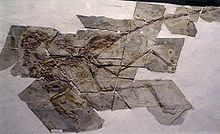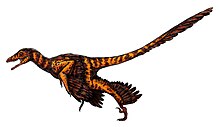Sinornithosaurus
| Sinornithosaurus Temporal range: Early Cretaceous,
| |
|---|---|

| |
| S. millenii fossil, Hong Kong Science Museum | |
| Scientific classification | |
| Domain: | Eukaryota |
| Kingdom: | Animalia |
| Phylum: | Chordata |
| Clade: | Dinosauria |
| Clade: | Saurischia |
| Clade: | Theropoda |
| Family: | †Dromaeosauridae |
| Clade: | †Microraptoria |
| Genus: | †Sinornithosaurus Xu, Wang & Wu, 1999 |
| Species | |
| |
Sinornithosaurus (derived from a combination of Latin and Greek, meaning 'Chinese bird-lizard') is a genus of feathered dromaeosaurid dinosaur from the Lower Cretaceous Period (early Aptian) of the Yixian Formation in what is now China.[1] It was the fifth non–avian feathered dinosaur genus discovered by 1999. The original specimen was collected from the Sihetun locality of western Liaoning. It was found in the Jianshangou beds of the Yixian Formation, dated to 124.5 million years ago. Additional specimens have been found in the younger Dawangzhangzi bed, dating to around 122 million years ago.[2]
Xu Xing described Sinornithosaurus and performed a phylogenetic analysis which demonstrated that it is basal, or primitive, among the dromaeosaurs.[3] He has also demonstrated that features of the skull and shoulder are very similar to Archaeopteryx and other Avialae. Together these two facts demonstrate that the earliest dromaeosaurs were more like birds than the later dromaeosaurs were. This talks against one argument made by critics of the theory that birds evolved from dinosaurs, namely that the most birdlike dinosaurs are predated by the earliest birds (see temporal paradox).[4]
Sinornithosaurus was among the smallest dromaeosaurids, with a length of about 90 centimetres (3.0 ft).[5]
Description
Feathers

Specimens of Sinornithosaurus have preserved impressions of feathers. They were composed of filaments, and showed two features that indicate they are early feathers. First, several filaments were joined together into "tufts", like the structure of down feather. Second, a row of filaments (barbs) were joined together to a main shaft (rachis), making them similar in structure to normal bird feathers. However, they do not have the secondary branching and tiny little hooks (barbules) that modern feathers have, which allow the feathers of modern birds to form a discrete vane.
Color
A 2010 study indicated that Sinornithosaurus may have had feathers which varied in color between significantly across different regions of the body, based on analysis of microscopic cell structures in preserved fossils.[6]
Classification


Sinornithosaurus was a member of the family Dromaeosauridae, a group of agile, predatory dinosaurs with a distinctive sickle-shaped toe claw, which also includes Deinonychus and Utahraptor. S. millenii lived about 125 million years ago in the Aptian age of the Early Cretaceous period, which makes it among the earliest and most primitive dromaeosaurids yet discovered. Fossils of S. haoiana and the possible Sinornithosaurus specimen NGMC 91 were found in younger strata dating to about 122 million years ago. The presence of vaned feathers on Sinornithosaurus is consistent with feather evidence from other dromaeosaurs.
Sinornithosaurus is known from at least two species. S. millenii ("millennium Chinese bird-lizard") is the type species, described in 1999. A second species, S. haoiana ("Hao's Chinese bird-lizard") was described by Liu et al. in 2004 based on a new specimen, D2140, which differed from S. millenii in features of the skull and hips.[7] An incredibly well-preserved microraptorian nicknamed "Dave" (specimen NGMC 91), has been suggested to represent a species of Sinornithosaurus, possibly a juvenile. However, phylogenetic analyses have suggested that NGMC 91 is in fact more closely related to Microraptor.[8]
Discovery and specimens
Sinornithosaurus was discovered by Xu Xing, Wang Xiaolin and Wu Xiaochun of the Institute of Vertebrate Paleontology and Paleoanthropology of Beijing. An almost-complete fossil with feather impressions, was recovered from Liaoning Province, China, in the Yixian Formation; the same incredibly rich location where four dinosaurs with feathers were discovered previously, Protarchaeopteryx, Sinosauropteryx, Caudipteryx, and Beipiaosaurus. The holotype specimen is IVPP V12811, in the collection of the Institute of Vertebrate Paleontology and Paleoanthropology in Beijing, China.
Paleobiology
Possible venomous bite
In 2009, a team of scientists led by Empu Gong examined a well-preserved Sinornithosaurus skull, and noted several features suggesting it was the first-identified venomous dinosaur. Gong and colleagues noted that the unusually long and fang-like mid-jaw (maxillary) teeth had prominent grooves running down the outer surface, towards the rear of the tooth, a feature seen only in venomous animals. They also interpreted a cavity in the jaw bone just above these teeth as the possible site for the soft-tissue venom gland. Gong and colleagues suggested that these unique features indicated that Sinornithosaurus may have specialized in hunting small prey such as birds, using its long fangs to penetrate feathers and envenomate and stun the prey, like a modern snake. They also suggested that the short, slightly forward-pointing teeth at the tip of the jaw could have been used to strip feathers from birds.[9]
However, in 2010, another team of scientists published a paper casting doubts on the claim that Sinornithosaurus was venomous. They noted that grooved teeth are not unique to this genus, and in fact grooved teeth are found in many other theropods, including other dromaeosaurids. They also demonstrated that the teeth were not abnormally long as Gong and his team claimed, but rather had come out of their sockets, a preservational artifact common in crushed and flattened fossils. Finally, they could not independently verify the presence of supposed chambers for venom glands cited by Gong's team, finding only the normal sinuses of the skull.[10]
In the same journal issue, Gong and his team submitted a rebuttal of the 2010 study casting doubt on their findings. They admitted that grooved teeth were common among theropods (though they suggested they were really only prevalent among feathered maniraptorans), and hypothesized that venom may have been a primitive trait for all archosaurs if not all reptiles, which was retained in certain lineages. They also disputed the claim that the teeth were significantly out of their sockets in the holotype specimen of Sinornithosaurus, though they admitted that they were not in a completely natural position. Gong's rebuttal also claimed that certain undescribed specimens had fully articulated teeth showing a similar length.[11]
Circadian rhythm
Comparisons between the scleral rings of Sinornithosaurus and modern birds and reptiles indicate that it may have been cathemeral, active throughout the day at short intervals.[12]
See also
References
- ^ Swisher, Carl C., Wang, Yuan-qing, Wang, Xiao-lin, Xu, Xing, Wang, Yuan. (1999). "Cretaceous age for the feathered dinosaurs of Liaoning, China". Nature 400:58-61 1 July 1999.
- ^ Zhou, Z. (2006). "Evolutionary radiation of the Jehol Biota: chronological and ecological perspectives." Geological Journal, 41: 377–393.
- ^ Xu, Xing, Wang, Xiao-Lin, Wu, Xiao-Chun. (1999) "A dromaeosaurid dinosaur with a filamentous integument from the Yixian Formation of China" "Nature" 401:262-266 16 September 1999.
- ^ Xu, Xing, Wu, Xiao-Chun. (2001). "Cranial morphology of Sinornithosaurus millenii Xu et al. 1999 (Dinosauria:Theropoda:Dromaeosauridae) from the Yixian Formation of Liaoning, China". Canadian Journal of Earth Sciences 38:1739-1752 (2001)
- ^ Holtz, Thomas R. Jr. (2011) Dinosaurs: The Most Complete, Up-to-Date Encyclopedia for Dinosaur Lovers of All Ages, Winter 2010 Appendix.
- ^ Zhang, F., Kearns, S.L., Orr, P.J., Benton, M.J., Zhou, Z., Johnson, D., Xu, X. and Wang, X. (In press). "Fossilized melanosomes and the colour of Cretaceous dinosaurs and birds." Nature, advanced online publication, 27 January 2010.
- ^ Liu, J., Ji, S., Tang, F. & Gao, C. (2004). "A new species of dromaeosaurids from the Yixian Formation of western Liaoning". Geological Bulletin of China. 23 (8): 778–783.
{{cite journal}}: CS1 maint: multiple names: authors list (link) (abstract) - ^ Senter, P. (2007). "A new look at the phylogeny of Coelurosauria (Dinosauria: Theropoda)." Journal of Systematic Palaeontology, 5: 429–463. doi:10.1017/S1477201907002143.
- ^ Gong, E., L.D. Martin, D.E. Burnham, and A.R. Falk. (2009). "The birdlike raptor Sinornithosaurus was venomous." Proceedings of the National Academy of Sciences, (not yet published)
- ^ Gianechini, F.A., Agnolín, F.L. and Ezcurra, M.D. (2010). "A reassessment of the purported venom delivery system of the bird-like raptor Sinornithosaurus." Paläontologische Zeitschrift, in press. doi:10.1007/s12542-010-0074-9
- ^ Gong, E., Martin, L.D., Burnham, D.A. and Falk, A.R. (2010). "Evidence for a venomous Sinornithosaurus." Paläontologische Zeitschrift, in press. doi:10.1007/s12542-010-0076-7
- ^ Schmitz, L.; Motani, R. (2011). "Nocturnality in Dinosaurs Inferred from Scleral Ring and Orbit Morphology". Science. in press. doi:10.1126/science.1200043.
{{cite journal}}: CS1 maint: multiple names: authors list (link)
External links
- Wang, L. (March 10, 2001). "Dinosaur fossil yields feathery structures". Science News.
- Sinornithosaurus at DinoData
